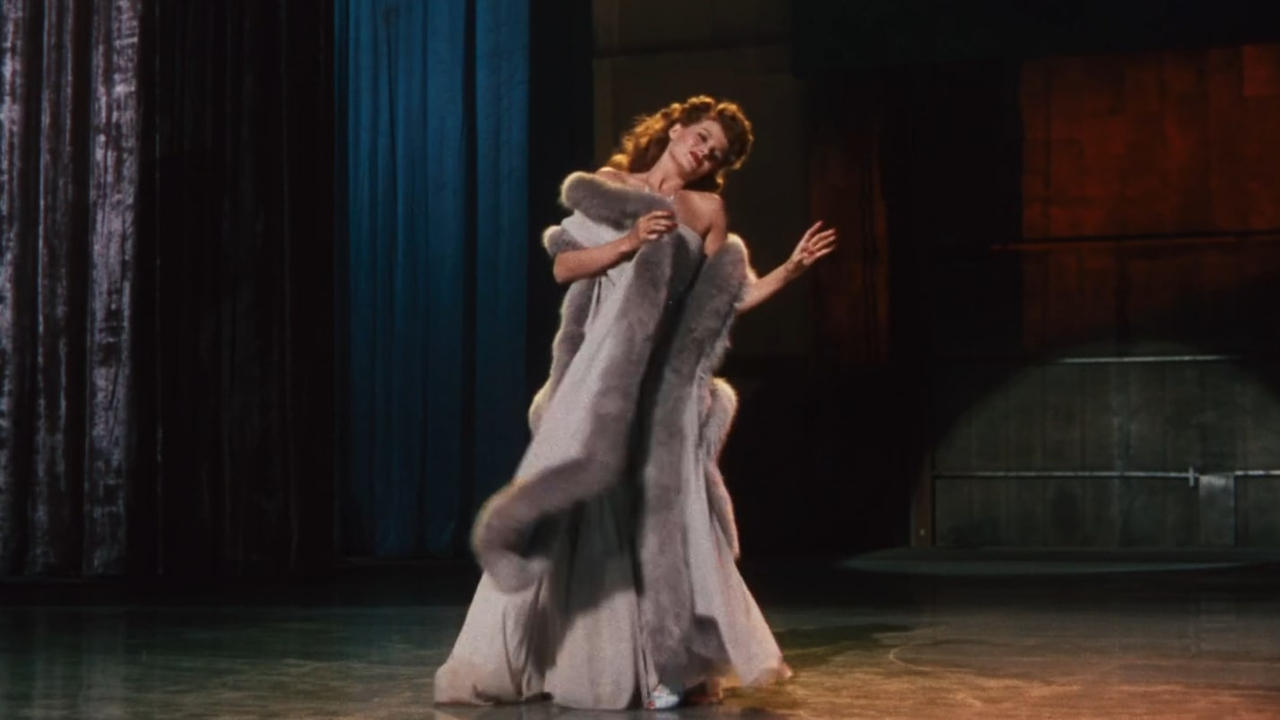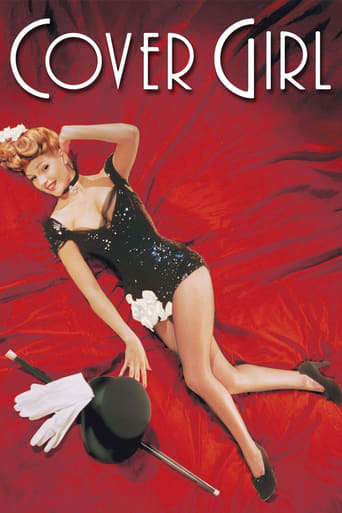

Rita Hayworth plays two characters and the title role in this musical comedy which won an Academy Award for Best Musical Score; the film also received Oscar nominations for its Color Art Direction-Interior Decoration, Cinematography and Sound; its Jerome Kern-Ira Gershwin original song "Long Ago and Far Away" was also nominated. It was directed by Charles Vidor, with a story by Erwin Gelsey and a screenplay by Virginia Van Upp; Marion Parsonnet and Paul Gangelin wrote the adaptation.Hayworth plays chorus girl singer-dancer Rusty Parker (and her grandmother Maribelle Hicks in flashback) opposite Brooklyn club owner and fellow performer Danny McGuire, played by Gene Kelly. Phil Silvers plays Genius, the third wheel and comedian in the trio that's struggling to make it big; they spend every Friday night at Joe's (Edward Brophy, uncredited) bar hoping to find a pearl in an oyster. When Rusty hears fellow chorus girl Maurine Martin (Leslie Brooks) discussing her dream to "get out of this dump and become famous" by auditioning for Vanity magazine's cover, she too decides to give it a try. But Maurine intentionally gives her some bad advice such that Rusty blows her chance with the fashion magazine's Cornelia 'Stonewall' Jackson (Eve Arden). Model Jinx Falkenburg appears briefly, as herself. Otto Kruger plays Vanity's owner, John Coudair; Jess Barker plays Coudair opposite Hayworth's character in the flashback sequences.Cornelia and Coudair go to McGuire's club one night to take another look at Maurine and he "discovers" Rusty, who bears a remarkable resemblance to his first love, singer-dancer Maribelle Hicks (Hayworth again), who'd left him at the altar for a piano player. Coudair puts Rusty on the next cover of his magazine and suddenly McGuire's Brooklyn club is all the rage. When Cornelia and Coudair take Broadway producer Noel Wheaton (Lee Bowman) to the club, he falls head over heals for Rusty and Coudair is only too happy to facilitate their introductions. Wheaton sends her flowers every day (via Billy Benedict's uncredited delivery boy) and, with Coudair's help, manages to sign her for his Broadway show. Naturally, this jeopardizes Rusty's relationship with Danny, whose jealously causes him to exacerbate the situation. Kelly performs a remarkable Stanley Donen-choreographed dance routine with (a ghost-like double exposure version of) himself. Danny and Genius enter military service - there's a war going on - while Rusty stars in Wheaton's show and drinks to salve her lost love. She walks down the aisle with Wheaton just like her grandmother had with Coudair, jilts him just the same, and returns to Danny at Joe's, where Genius joins and the three of them happily dance to the end, together again.
... View MoreWill success spoil Rusty Parker? Rusty, a chorus girl working at a nightclub run by her boyfriend Danny McGuire, gets a chance to go for the big time after being chosen as the cover girl for a prestigious magazine. Rusty becomes a Broadway star, but success threatens to spoil her romance with Danny when she is pursued by the magazine's editor John Coudair and by her Broadway producer Noel Wheaton. As, however, Coudair is old enough to be Rusty's grandfather- indeed, forty years earlier he was a suitor for her grandmother's hand- and Wheaton is the coldest of cold fish, we all know how the story will end. And that's about it as far as plot is concerned, although a couple of flashbacks tell us something of John's romance with Rusty's grandmother Maribelle. (Although these scenes are ostensibly set forty years previously in the Edwardian era, there is little attempt at period accuracy and some of the costumes are those of the 1940s).Despite the scanty plot, "Cover Girl" was one of the most popular musicals of the war years. Indeed, plot was often regarded as relatively unimportant in musicals from this period. Even a film as highly regarded as that other Gene Kelly vehicle "An American in Paris" is really about little more than a boy, a girl and a happy ending. What mattered were sentiment, spectacle, songs, dance numbers and an overall feel-good factor. This was particularly important during the war. Despite the film's happy-go-lucky atmosphere, we are not allowed to forget that it is 1944 and there is a war to be won. Phil Silvers as the nightclub's resident comedian Genius includes plenty of jokes about the war in his act, and we learn that Danny is a former soldier invalided out of the Army after being wounded. This is one of those wartime movies which try to help the war effort, not by pushing a heavy-handed propagandist message but by keeping up civilian morale. Most of the musical routines are relentlessly cheerful with a message of "better times are just around the corner".The film is said to be the film which made a star of Gene Kelly, although at the time it was primarily intended as a vehicle for the talents of Rita Hayworth, a rising young star at the time, showcasing not just her looks but also her skills as a dancer. She has a double role, playing both Rusty and Maribelle. Her talents did not, it would seem, extend to singing, as her voice was dubbed. This was not an uncommon phenomenon at this period; Hayworth's younger contemporary Cyd Charisse danced her way throughout numerous musicals without singing a note in any of them. During this phase of Hayworth's career she was normally offered "sweet girl next door" type parts like Rusty here. Later in the decade she would be given the opportunity to play sultry femmes fatales, as in "Gilda" and "The Girl from Shanghai", before moving on in the fifties to "sexy older woman" roles. "Gilda", incidentally, had the same director, Charles Vidor, as "Cover Girl", but the two films are very different from one another.Trying to evaluate a film like this one is a difficult task seventy years on. It belongs to a tradition of lavish Hollywood musicals which is no longer really part of our culture, having come to an end in the seventies soon after those two late, great examples "Fiddler on the Roof" and "Cabaret". Sporadic attempts to revive this tradition have not always met with success. Moreover, the musicals of the thirties and forties can often seem stylised and unrealistic, even by the standards of their successors from the fifties and sixties. Yet we have to bear in mind that this film was a great success in its day, and it is worth trying to understand why.The songs are tuneful, although none of them except perhaps "Long Ago and Far Away" has really become a classic. The dance numbers are well produced and the two leading stars are attractive and charismatic. Kelly's contribution, moreover, went well beyond just acting and dancing; he was also responsible for a lot of the choreography. The elaborate costumes also contributed a lot to the film's success. (This was, remember, an age of austerity).Seen through modern eyes, "Cover Girl" looks horribly dated, but if we make the effort to see it through the eyes of our grandparents, it still has a lot to recommend it. 7/10
... View MoreRusty's a popular singer-dancer for small-timer Mcguire's club, but gets her head turned by fancy impresario Wheaton who wants her to leave her friends and take her talents to his swanky uptown stage show.Talk about eye candy. There's enough glamour here to send guys into a sugar overload. I hope they didn't show this WWII production overseas, otherwise a million GI's would be swimming home. I've seen a sexier Hayworth, but never a more sparkling one. She's obviously enjoying herself, and why not, she's got Kelly as a partner and a goofy Silvers to keep her in stitches. And get a load of the hats the gals wear. Some look like they're getting messages from Mars.Okay, except for "Long Ago and Far Away", the tunes are pretty forgettable, while that set-up in the trooper cattle car should have been seriously re-thought. Still, I thought that dancing threesome down the city street was utterly charming, and reminded me of Kelly's signature number in Singin' in the Rain (1952). Then too, actor Bowman (Wheaton) makes a perfect Manhattan lounge lizard. For younger folks, there were a lot of references to Brooklyn during the war. That's because the New York borough came to symbolize the common man and the American melting pot-- in short, the kind of national unity that winning the war would need. So, naturally, good guy McGuire (Kelly) has his stage show there, while slickster Wheaton has his in more snobbish uptown Manhattan. So Rusty (Hayworth) has to learn it's more fun to crack oysters in a Brooklyn bar than sip martinis in an swanky lounge.Anyhow, it's hard to think of a brighter, more colorful production than this line-up of Hollywood glamour that keeps "comin' at yuh", one pretty face after another.
... View MoreSinger/dancer "Rusty" Park (Rita Hayworth) performs at Danny McGuires and is romanced by the owner--Danny (Gene Kelly). She is spotted by a magazine agency and they hire her to become their new cover girl. She becomes an overnight sensation and is happy...but all this fame threatens her romance with Danny.The story is sappy but you don't watch this for the plot! You watch to see Hayworth, Kelly and a young Phil Silvers singing and dancing and there's a LOT of that. The numbers are in bright beautiful Technicolor, Hayworth is incredibly beautiful and the dancing is astonishing. We also have Eve Arden in a small role providing some comic relief. This also has some pleasant if forgettable songs except for the haunting "Long Ago and Far Away" (Oscar-nominated). Also there's the "Alter Ego" dance where Kelly dances with himself! However this isn't perfect. The totally predictable story drags this down a little, it's a bit too long and a little of Silvers comedy goes a long way but it's still well worth watching.Just be careful if you see it on commercial TV. I saw it originally back in the early 1970s on TV...and it was in b&w!
... View More